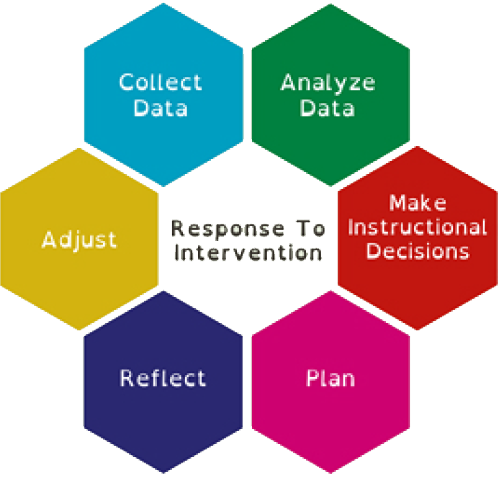-
OUR SEQUENCE AND
STRUCTURE
Our approach is data driven. That means we do not make any assumptions about a child’s reading level. We follow a scientifically sound problem solving approach that leads us directly to understanding the reasons for the reading deficit.
Learning to read consists of developing skills in two critical areas:
(1) Reading each word in texts accurately and fluently and
(2) Comprehending the meaning of texts being read. This is known as the Simple View of Reading.
To read words accurately and fluently, students need strategies to read words they have never seen before in print as well as words they have previously encountered. To understand the meaning of texts, students must have sufficient language comprehension skills. For example, if a text says, “the little dog barked at the big cat,” a proficient reader must be able to read each word accurately and also know what the words mean in this specific sentence. Learning these skills does not come naturally. Both accurate word reading and text comprehension require careful, systematic instruction. And, once formal reading instruction begins in school, instruction in both of these areas should occur on a daily basis.”
Lead Author: Scott K. Baker, Ph.D.
Elements of The Lesson Structure
Read Like A Champion follows an Orton Gillingham based approach together with other approaches geared at a holistic development of the learner. The Orton-Gillingham Approach is a direct, explicit, multisensory, structured, sequential, diagnostic, and prescriptive way to teach literacy when reading, writing, and spelling does not come easily to individuals, such as those with dyslexia. It is most properly understood and practiced as an approach, not a method, program, or system. In the hands of a well-trained and experienced instructor, it is a powerful tool of exceptional breadth, depth, and flexibility.
Brain Gymnastics
Each lesson begins with a one minute brain exercise. This exercise MUST be done daily before any formal part of the lesson begins.
Ten Benefits of Brain Gymnastics for Struggling Readers:
1. It helps learners think more clearly.
2. It relaxes and calms the learner.
3. It improves hand-eye co-ordination.
4. It improves visual tracking (moving you eyes and not your head to see something)
5. It increase attention span.
6. It increase writing flow and speed.
7. It balances emotions.
8. It improves memory.
9. It improves cross laterality (crossing the mid-line of the body, your belly button, connects the right and left hemisphere).
10. It helps to develop hand dominance (being right or left handed).
Read- Alouds and Building Schema in Both English and Mother Tongue
Betty Hart and Todd Risley conducted research during the 1960’s to look at the vocabulary gap in children from poorer communities. They found that children from poorer households entered formal education with a 30 million vocabulary deficit. Their findings were heavily criticized by both white and black critics- citing that their sample was made up of merely 42 families. I am not an academic- I am a teacher concerned with the declining reading levels in poor communities globally. As a South African my contribution to the argument would have centered around ‘Mother Tongue.’ Children from poorer families do enter formal education with a vocabulary deficit in ENGLISH! Most of our Township children speak a FANAGALO (OR PERHAPS A Patois) of English and whatever they hear at home. Read Like A Champion makes a concerted effort to help these children read and understand in both Mother Tongue Langauges and English. Trainees are encouraged to read stories both in English and in Mother Tongue and to translate materials to Mother Tongue as far as possible.
Orton Gillingham Approach Principles
Personalized-
Recognizing the different needs of learners.
Multi-Sensory-
It uses all the learning pathways: seeing, hearing, feeling, and awareness of motion, brought together by the thinking brain.
Emotionally Sound-
Students feelings about themselves and about learning are vital. Teaching is directed toward providing the experience of success. With success comes increased self-confidence and motivation.
Diagnostic and Prescriptive-
Our lessons are diagnostic in the sense that the tutor or teacher continuously monitors the verbal, nonverbal, and written responses of the student to identify and analyze both the student’s problems and progress. Our lessons are prescriptive in the sense that it will contain instructional elements that focus upon the resolution of the learner’s difficulties and that build upon the learner’s progress noted in the previous lesson.
Direct Instruction-
The teacher presentations uses lesson formats that ensure the student approaches the learning experience understanding what is to be learned, why it is to be learned, and how it is to be learned.
Systematic Phonics-
It uses systematic phonics, stressing the alphabetic principle in the initial stages of reading development. It takes advantage of the sound/symbol relationships inherent in the alphabetic system of writing. Spoken words are made up of individual speech sounds, and the letters of written words graphically represent those speech sounds.
Systematic and Structured-
The teacher/tutor presents information in an ordered way that indicates the relationship between the material taught and past material taught.
Sequential, Incremental and Cumulative-
Step-by-step learners move from the simple, well-learned material to that which is more and more complex. They move from one step to the next as they master each level of language skills.
Continuous Feedback and Positive Reinforcement-
The Approach provides for a close teacher-student relationship that builds self-confidence based on success.
Cognitive Approach-
Students understand the reasons for what they are learning and for the learning strategies they are employing. Confidence grows as they gain in their ability to apply newly acquired knowledge about and knowledge how to develop their skills with reading, spelling, and writing.

